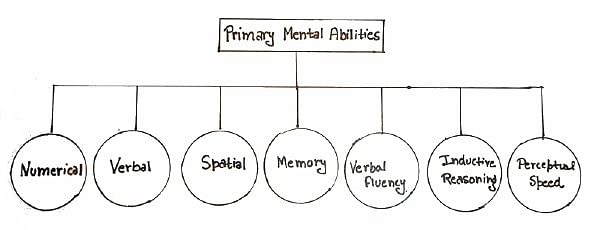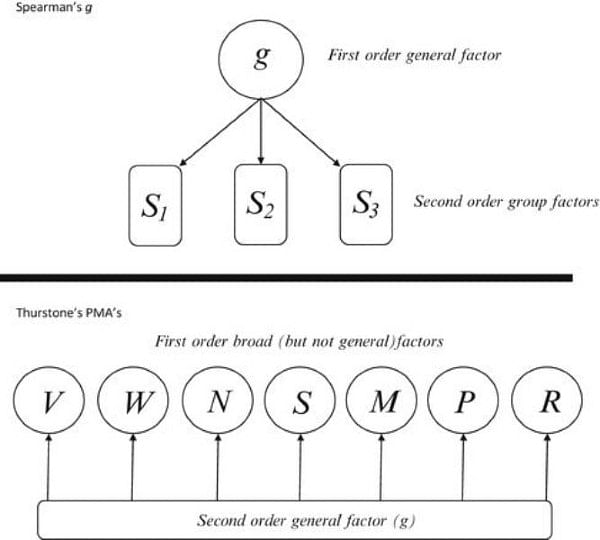Notes: Thurstone Group Factor Theory of Intelligence | Child Development and Pedagogy for CTET Preparation - CTET & State TET PDF Download
Thurstone’s Theory of Intelligence
Thurstone’s multi-factor theory of intelligence is based on the generalized concepts, formulas, and methods used by Spearman in his Two-factor Theory of intelligence. Thurstone used the new advanced technique of factor analyses to Spearman’s factor analysis technique to understand the various factors related to human intelligence. In his research, he conducted 57 psychological mental abilities tests on the group of subjects and examined the tests scores of these subjects through the inter-correlation technique and matrix algebra. The conclusion derived by Thurstone about the nature of intellectual abilities was different from that of Spearman’s conclusion. Based on the gathered data, Thurstone stated that there exist seven different mental abilities factors, and he called them the primary mental abilities (P.M.A.). He rejected to accept the general intelligence or g-factor of Spearman’s theory because Thurstone’s seven mental abilities fitted better per the obtained data as compared to Spearman’s general intelligence (g-factor). According to Spearman, there exists a general factor called the g-factor that is common to all the intellectual abilities of the person. However, Thurstone stated that human intellectual abilities are diverse, and he established his multi-factor theory of intelligence (1935) that focuses on the seven different primary mental abilities. He stated that every individual possesses different levels of these seven factors, and these levels do not depend on each other, and each of these abilities can be evaluated separately. He suggested focusing on the individual’s scores in various mental abilities instead of focusing only on the intelligence quotient of the person. Let us discuss these seven primary mental ability factors.

1. The Numerical Factor
It involves the ability of an individual to do quick and accurate numerical computations. It can be measured by checking the accuracy and speed of the person in solving various arithmetic problems.
2. The Verbal Factor
It refers to the ability of the person to understand and use various words, sentences, language, or other verbal content pieces. This ability can be assessed through vocabulary tests, jumble word tests, and verbal or reading comprehension tests.
3. The Space Factor
It refers to the spatial visualization of the person. This ability comes into play when the person tries to understand the manipulation of various real/imaginary objects in space. The test that measures this ability involves solving various kinds of puzzles, understanding various geometric figures, and identifying the correct mirror image of the object, or choosing the correct image of the object when it is rotated by different angles.

4. Memory
It refers to the ability of the person to quickly memorize the various concepts or phenomena and retaining them for a longer period of time. Various memory tests like asking the participants to learn nonsense syllables, and their ability to remember them could be a measure of their memory factor. The ability to recall the learned concepts by the students during the exams is largely dependent on this primary mental ability factor.
5. The Verbal Fluency/Word Fluency Factor
When a person is asked to rapidly speak several isolated words or sentences, then verbal fluency comes into play; a person with high verbal fluency may excel in this task, while the person with low verbal fluency may have difficulty in this task. This factor is responsible for the communication skills of the person. The tests to measure this factor may involve asking participants to rapidly think of words that begin or end with a specific letter.
6. The Inductive Reasoning Factor
This reasoning involves the ability to deduce a general principle from a specific concept. This ability is measured through various tests like number series, word series, and classification of words or numbers. The inductive reasoning tests may involve selecting an appropriate number or image according to the sequential order of the given numbers or images series.

7. Perceptual Speed Factor
It involves the ability of a person to rapidly recognize and compare the specific images, numbers, or letters, and to accurately proofread various types of content. Tests like picture recognition, rapidly crossing specific letters from the series of numbers, and finding particular words in the paragraphs are used to measure the perceptual speed factor of the person.

On further research of his multi-factor theory of intelligence, Thurstone added two more factors in his seven primary mental abilities, and these are given below.
8. The Deductive Reasoning Factor
It involves the ability to accurately understand a specific phenomenon or concept from the generalized principle. Various aptitude tests are available to test the deductive reasoning of the person that includes the various set of statements, and the person has to choose the best possible logical solution according to the given statements.
9. Problem-Solving Ability Factor
It refers to the ability of a person to solve various general or aptitude problems. This factor can be assessed by analyzing the individual’s responses to various hypothetical problems, and their ability to reach the conclusion.
Research Method: Spearman’s Theory of Intelligence vs Thurstone’s Theory of Intelligence
Hans Eysenck, a British psychologist known for his work in the psychology of intellectual development and personality, explained the variations in the conclusion derived from Thurstone and Spearman. He said that the conflict between the two findings is because of the differences in the research technique of both theories. Firstly, it may be because of variation in the sample population of both theories. Spearman conducted his research on random people that usually consisted of children, while Thurston’s research sample only consisted of students. The second reason maybe because of the different choices of various mental tests used in their research. The tests that Spearman used in his study were quite different from each other because if the tests were identical to each other, the “s” factor (specific ability) may have overlapped, which would have resulted in additional correlations among the different variables, while the tests that Thurstone used in his research were almost identical with each other. According to Thurstone’s theory of intelligence, the seven primary mental abilities are independent of each other, but when Thurstone conducted his primary mental abilities tests on the group of children with heterogeneous intellectual abilities, he failed to prove that the seven primary mental abilities were separate from each other, instead, he discovered the presence of the g factor. He further did the statistical analysis and managed to explain this contradiction. He proposed that there exist both the general factor and seven primary specific mental abilities. This final interpretation of his theory helped the other psychologists develop various hierarchical and multiple intelligence theories. Hence, we can not say that Thurstone’s theory fully challenges the ‘general intelligence’ concept of Spearman’s two-factor theory of intelligence.

|
68 videos|63 docs|36 tests
|
FAQs on Notes: Thurstone Group Factor Theory of Intelligence - Child Development and Pedagogy for CTET Preparation - CTET & State TET
| 1. What is Thurstone's Group Factor Theory of Intelligence? |  |
| 2. How does Thurstone's Theory of Intelligence differ from other theories of intelligence? |  |
| 3. What are the primary mental abilities according to Thurstone's Group Factor Theory of Intelligence? |  |
| 4. How does Thurstone's Theory of Intelligence impact education and testing? |  |
| 5. What is the relevance of Thurstone's Theory of Intelligence in today's context? |  |
|
68 videos|63 docs|36 tests
|

|
Explore Courses for CTET & State TET exam
|

|

















